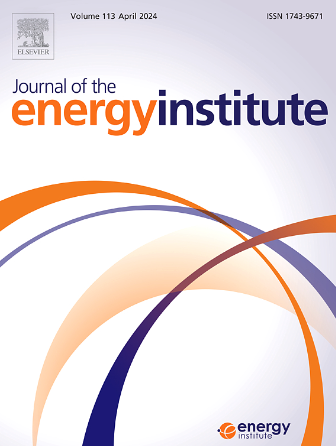Kinetic analysis and fuel characterization with hydrocarbon distribution in pyro-oil produced from co-pyrolysis of rice husk and low-density polyethylene
IF 5.6
2区 工程技术
Q2 ENERGY & FUELS
引用次数: 0
Abstract
The expansion of the human population, urbanization, environmental damage, and energy demand have depleted the fossil fuel supply. As a result, the primary problems of the current global socioeconomic restructuring require substantial and long-term alternative energy resources. This study studies the synergistic potential of co-pyrolysis, a promising thermochemical conversion process, to produce hydrocarbon-rich fuel from a blend of low-density polyethylene (LDPE) and rice husk biomass. The thermal behavior of the blended feedstock at different weight ratios was investigated using TGA. For pyrolysis experiments, several mixes of waste plastics (80, 60, and 50 wt%) were combined with biomass and pyrolyzed in a semi-batch reactor under optimal conditions (550 °C temperature, 10 °C/min heating rate, and 200 mL/min N2 flow rate). The fuel characteristics of co-pyrolyzed fuel were assessed using ASTM techniques. The physicochemical parameters of the co-pyrolyzed fuel were characterized using experimental investigations, which included its energy content, elemental composition, density, viscosity, and stability. The results show that pyrolyzing LDPE and rice husk together produces a hydrocarbon-rich fuel with good combustion properties. The fuel has higher energy content and lower viscosity than individual feedstocks, making it a feasible alternative to traditional petroleum-based fuels. FTIR and NMR investigations indicated the presence of a variety of functional groups, most notably aromatic compounds, acids, phenols, water, esters, and ethers. Furthermore, NMR study indicated that adding waste plastics enhances aromatic content while decreasing paraffinic chemicals. Furthermore, a GC-MS examination revealed a considerable rise in hydrocarbons and decreased oxygen-rich compounds when waste plastic LDPE was added to the blend.

稻壳与低密度聚乙烯共热解油中烃类分布的动力学分析及燃料表征
人口膨胀、城市化、环境破坏和能源需求已经耗尽了化石燃料供应。因此,当前全球社会经济结构调整的主要问题需要大量和长期的替代能源。本研究研究了共热解的协同潜力,这是一种有前途的热化学转化过程,从低密度聚乙烯(LDPE)和稻壳生物质的混合物中生产富含碳氢化合物的燃料。采用热重分析仪研究了不同重量比下混合原料的热行为。在热解实验中,在最佳条件(550℃温度、10℃/min升温速率、200 mL/min N2流量)下,将几种废塑料(80%、60%和50% wt%)与生物质混合,在半间歇反应器中进行热解。使用ASTM技术对共热解燃料的燃料特性进行了评估。通过实验研究表征了共热解燃料的理化参数,包括其能量含量、元素组成、密度、粘度和稳定性。结果表明,LDPE与稻壳共同热解可制得燃烧性能良好的富碳氢燃料。与单个原料相比,该燃料具有更高的能量含量和更低的粘度,使其成为传统石油基燃料的可行替代品。红外光谱(FTIR)和核磁共振(NMR)研究表明存在多种官能团,最明显的是芳香族化合物、酸、酚、水、酯和醚。此外,核磁共振研究表明,废塑料的加入提高了芳烃含量,降低了石蜡类化合物的含量。此外,GC-MS检查显示,当废塑料LDPE添加到混合物中时,碳氢化合物显著增加,富氧化合物减少。
本文章由计算机程序翻译,如有差异,请以英文原文为准。
求助全文
约1分钟内获得全文
求助全文
来源期刊

Journal of The Energy Institute
工程技术-能源与燃料
CiteScore
10.60
自引率
5.30%
发文量
166
审稿时长
16 days
期刊介绍:
The Journal of the Energy Institute provides peer reviewed coverage of original high quality research on energy, engineering and technology.The coverage is broad and the main areas of interest include:
Combustion engineering and associated technologies; process heating; power generation; engines and propulsion; emissions and environmental pollution control; clean coal technologies; carbon abatement technologies
Emissions and environmental pollution control; safety and hazards;
Clean coal technologies; carbon abatement technologies, including carbon capture and storage, CCS;
Petroleum engineering and fuel quality, including storage and transport
Alternative energy sources; biomass utilisation and biomass conversion technologies; energy from waste, incineration and recycling
Energy conversion, energy recovery and energy efficiency; space heating, fuel cells, heat pumps and cooling systems
Energy storage
The journal''s coverage reflects changes in energy technology that result from the transition to more efficient energy production and end use together with reduced carbon emission.
 求助内容:
求助内容: 应助结果提醒方式:
应助结果提醒方式:


